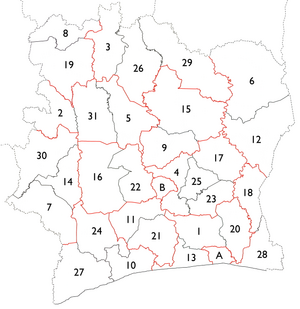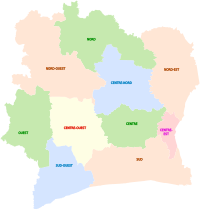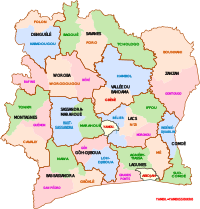| Politics of Ivory Coast |
|---|
 |
| Constitution |
| Government |
Parliament
|
| Administrative divisions |
| Elections |
Foreign relations
|
| Recent history |
|
|

The regions of Ivory Coast (French: régions de la Côte d'Ivoire) are the second-level subdivisions of Ivory Coast. There are 31 regions, and each region is subdivided into two or more departments, the third-level division in Ivory Coast. Two to four regions are combined to make up an autonomous district, the first-level subdivision. The autonomous districts of Abidjan and Yamoussoukro are not divided into regions.
History
The first 10 regions were established in 1990. At the time, they supplanted the departments as the first-level administrative subdivisions of the country, with the departments being converted into second-level subdivisions. Two new regions were added in 1996. Four new regions were added in 1997, and all the existing regions changed their names, bringing the total to 16. In 2000, four of the regions were divided to create three more regions, bringing the total to 19.
Prior to the 2011 reorganisation of the subdivisions of Ivory Coast, the 19 regions were the first-level subdivision of the country. In the reorganisation, districts were created and replaced regions as the first-level subdivisions and the 19 regions were reorganized into 30. In 2012, one region was divided to create a 31st region.
In 2014, the districts were abolished except for the two autonomous districts of Abidjan and Yamoussoukro. Then in 2021 the former districts were reinstated as autonomous districts.
Maps of regions through the time
Governance and purpose
The executive of each region is headed by a prefect, who is appointed by the council of ministers (cabinet) of the national government. For departments that house regional capitals, the prefect of the department is the same individual as the prefect of the region, though the two offices of prefect remain distinct. The legislative body of the region is the Regional Council, which is elected and headed by a President.
The government of each region is responsible for designing and implementing programmes to improve the economic, social, and cultural life of the region. Regions are also responsible for coordinating and harmonising the activities of their departmental governments and for implementing public interest projects established by the district or the national government.
Regions
There are currently 31 regions of Ivory Coast. Two areas of the country, the autonomous districts of Abidjan and Yamoussoukro, are not divided into regions. The regions are as follows, with the date of creation in parentheses:

- Agnéby-Tiassa (2011)
- Bafing (2000)
- Bagoué (2011)
- Bélier Region (2011)
- Béré (2011)
- Bounkani (2011)
- Cavally (2011)
- Folon (2011)
- Gbêkê (2011)
- Gbôklé (2011)
- Gôh (2011)
- Gontougo (2011)
- Grands-Ponts (2011)
- Guémon (2011)
- Hambol (2011)
- Haut-Sassandra (1997)
- Iffou (2011)
- Indénié-Djuablin (2011)
- Kabadougou (2011)
- La Mé (2011)
- Lôh-Djiboua (2011)
- Marahoué (1997)
- Moronou (2012)
- Nawa (2011)
- N'Zi (2011)
- Poro (2011)
- San-Pédro (2011)
- Sud-Comoé (1997)
- Tchologo (2011)
- Tonkpi (2011)
- Worodougou (1997)
- A. Abidjan Autonomous District (2011) (not a region or divided into regions)
- B. Yamoussoukro Autonomous District (2011) (not a region or divided into regions)
The 14 autonomous districts (of which two are not subdivided into regions) and the 31 regions are listed below, with their regional seats and populations at the 2014 census.
| District | District capital | Regions | Region seat | Population |
|---|---|---|---|---|
| Abidjan (District Autonome d'Abidjan) |
4,707,404 | |||
| Bas-Sassandra (District du Bas-Sassandra) |
San-Pédro | Gbôklé | Sassandra | 400,798 |
| Nawa | Soubré | 1,053,084 | ||
| San-Pédro | San-Pédro | 826,666 | ||
| Comoé (District du Comoé) |
Abengourou | Indénié-Djuablin | Abengourou | 560,432 |
| Sud-Comoé | Aboisso | 642,620 | ||
| Denguélé (District du Denguélé) |
Odienné | Folon | Minignan | 96,415 |
| Kabadougou | Odienné | 193,364 | ||
| Gôh-Djiboua (District du Gôh-Djiboua) |
Gagnoa | Gôh | Gagnoa | 876,117 |
| Lôh-Djiboua | Divo | 729,169 | ||
| Lacs (District des Lacs) |
Dimbokro | Bélier | Yamoussoukro | 346,768 |
| Iffou | Daoukro | 311,642 | ||
| Moronou | Bongouanou | 352,616 | ||
| N'Zi | Dimbokro | 247,578 | ||
| Lagunes (District des Lagunes) |
Dabou | Agnéby-Tiassa | Agboville | 606,852 |
| Grands-Ponts | Dabou | 356,495 | ||
| La Mé | Adzopé | 514,700 | ||
| Montagnes (District des Montagnes) |
Man | Cavally | Guiglo | 459,964 |
| Guémon | Duékoué | 919,392 | ||
| Tonkpi | Man | 992,564 | ||
| Sassandra-Marahoué (District du Sassandra-Marahoué) |
Daloa | Haut-Sassandra | Daloa | 1,430,960 |
| Marahoué | Bouaflé | 862,344 | ||
| Savanes (District des Savanes) |
Korhogo | Bagoué | Boundiali | 375,687 |
| Poro | Korhogo | 763,852 | ||
| Tchologo | Ferkessédougou | 467,958 | ||
| Vallée du Bandama (District de la Vallée du Bandama) |
Bouaké | Gbêkê | Bouaké | 1,010,849 |
| Hambol | Katiola | 429,977 | ||
| Woroba (District du Woroba) |
Séguéla | Béré | Mankono | 389,758 |
| Bafing | Touba | 183,047 | ||
| Worodougou | Séguéla | 272,334 | ||
| Yamoussoukro (District Autonome du Yamoussoukro) |
355,573 | |||
| Zanzan (District du Zanzan) |
Bondoukou | Bounkani | Bouna | 267,167 |
| Gontougo | Bondoukou | 667,185 | ||
Regions before 2011

Before a reorganization in 2011, the regions were the first-level subdivisions of Ivory Coast. The 19 regions that existed immediately prior to the reorganisation were as follows, with their creation date in parentheses:
- Agnéby (1997)
- Bafing (2000)
- Bas-Sassandra (1997)
- Denguélé (1997)
- Dix-Huit Montagnes (1997)
- Fromager (2000)
- Haut-Sassandra (1997)
- Lacs (1997)
- Lagunes (1997)
- Marahoué (1997)
- Moyen-Cavally (2000)
- Moyen-Comoé (1997)
- N'Zi-Comoé (1997)
- Savanes (1997)
- Sud-Bandama (1997)
- Sud-Comoé (1997)
- Vallée du Bandama (1997)
- Worodougou (1997)
- Zanzan (1997)
As is the case now, regions were further divided into departments.
See also
Bibliography
- SATO Akira (2003). "L'évolution historique de la subdivision territoriale administrative en Côte d'Ivoire" in L'administration locale en Côte d'Ivoire. Africa Research Studies 10. 日本貿易振興機構(ジェトロ)アジア経済研究所 / Institute of Developing Economies, Japan External Trade Organization (IDE-JETRO). 2003. On-line.
References
- ^ Sato (2003).
- "Décentralisation : Le gouvernement créé 12 districts et 30 régions", abidjan.net, 29 September 2011.
- Décret n°2011-263 du 28 septembre 2011 portant organisation du territoire national en Districts et en Régions.
- "Conseil des Ministres du mercredi 04 Juillet 2012 : De nouvelles entités administratives créées", abidjan.net, 5 July 2012.
- Décret n° 2012-612 du 04 juillet 2012 portant création de la Région du Moronou.
- ""DECENTRALISATION: 12 NOUVEAUX DISTRICTS AUTONOMES CREES". gouv.ci. 18 June 2021. Retrieved 25 January 2023.
- ^ Loi n° 2014-451 du 5 août 2014 portant orientation de l'organisation générale de l'Administration Territoriale.
- Ordonnance n° 2011-262 du 28 septembre 2011 portant orientation de l'organisation générale de l'administration territoriale de l'Etat.
- "Districts of Côte d'Ivoire". Statoids. Institut National de la Statistique, Côte d'Ivoire.
- While Yamoussoukro is the seat of Bélier region, the city itself is not part of the region.
- "Regions of Côte d'Ivoire". Statoids.
| Articles on second-level administrative divisions of African countries | |
|---|---|
| |
| List of administrative divisions by country |
- Regions of Ivory Coast
- Subdivisions of Ivory Coast
- Lists of administrative divisions
- Administrative divisions in Africa
- Second-level administrative divisions by country
- Ivory Coast geography-related lists
- 1991 establishments in Ivory Coast
- States and territories established in 1991
- Regions of West Africa by country







